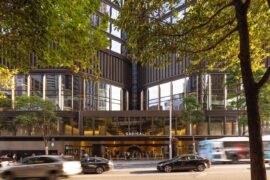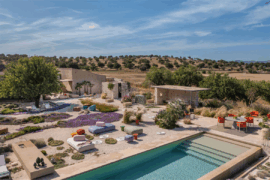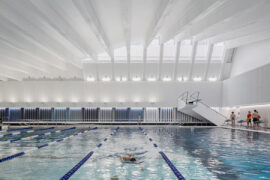Former principal at ThomsonAdsett, Sally Brincat, sits down with Leanne Amodeo to discuss the importance of biophilic design in shaping Wollert Primary School, one of the projects featured in Indesign 88: The Education Outlook Issue.

Sally Brincat, photography by Jeremy Veitch.
December 8th, 2022
What was the driving design concept?
As a Supported Inclusion Hub, Wollert Primary School provides accessible facilities for students with a range of learning needs and physical abilities. We recognise that students’ connection to the natural world greatly enhances their mental and emotional wellbeing, leading to better learning outcomes.
We wanted to provide some students, for whom school might be a tricky environment, an opportunity to engage with the principles of biophilia to bring calm and beauty, which in turn makes school more enjoyable. The ability to moderate the environment to respond to the students, the lesson plan or the weather encourages learning to bleed from the edges of a classroom or building on a whim.

Were there any challenges?
We had a steep slope, cultural heritage areas, ancient protected trees, services and flood easements, constrained site access and half a road. What we achieved responds to the pedagogical aims for a Supported Inclusion Hub within a school campus that honours and respects the past history of the site. The ‘challenges’ only enhanced the outcome and provided the opportunity to embed a connection to nature within the school pedagogy and curriculum delivery.
Related: SJB and seizing the aha! moment

How did you approach the dissolution of boundaries between inside and out?
The main emphasis was to dissolve the ubiquitous concrete apron we typically find around school buildings and replace it with rich Indigenous planting and a variety of outdoor learning areas. At entryways we broke down the building facade to provide good visual permeability to the outdoors with self-shading corners and inserted window-boxes in key areas to accentuate a view out of a classroom. Adjacent to shared collaborative zones we created a mix of covered and uncovered outdoor learning spaces to draw learning activities outdoors.

Has biophilic design facilitated a better learning environment for students?
The play spaces are a mix of structured and unstructured play, with the nature play area sitting alongside a protected rocky outcrop with Indigenous significance. As Wollert Primary School develops and grows, opportunity exists for additional engagement with local Indigenous Elders to further enhance this aspect of their learning.
Was there anything new in your biophilic design-led approach?
We took the principles of biophilic design, overlaid them with what we know about designing for neuro-diversity and then embedded them into the buildings, landscape and urban design. The variety in the landscape for active and passive recreation, refuge and aspect are intertwined with universal design principles to create a rich external environment that bleeds through and into the buildings and the pedagogy.

What do you think is most innovative about this project?
The garden beds that hug the buildings are one of the most successful elements. Bringing the planting up to the windows blurs the edges and carries the gardens into the buildings. Sitting in a sunny window seat and looking out over the rolling hills embeds an emotional response to history and culture in a holistic and visceral way. And the response from the school has been extremely positive, with one education support staff member telling us she felt an overwhelming sense of calm when she first walked in. It doesn’t get any better than that.

ThomsonAdsett
thomsonadsett.com
Law Architects
lawarchitects.com.au
Indesign #88: The Education Outlook issue is available here!
INDESIGN is on instagram
Follow @indesignlive
A searchable and comprehensive guide for specifying leading products and their suppliers
Keep up to date with the latest and greatest from our industry BFF's!

London-based design duo Raw Edges have joined forces with Established & Sons and Tongue & Groove to introduce Wall to Wall – a hand-stained, “living collection” that transforms parquet flooring into a canvas of colour, pattern, and possibility.

Rising above the new Sydney Metro Gadigal Station on Pitt Street, Investa’s Parkline Place is redefining the office property aesthetic.

Merging two hotel identities in one landmark development, Hotel Indigo and Holiday Inn Little Collins capture the spirit of Melbourne through Buchan’s narrative-driven design – elevated by GROHE’s signature craftsmanship.

At Melbourne Design Week, Plus Studio brought together planners, designers and local government voices to unpack the realities of urban densification.

Merging two hotel identities in one landmark development, Hotel Indigo and Holiday Inn Little Collins capture the spirit of Melbourne through Buchan’s narrative-driven design – elevated by GROHE’s signature craftsmanship.
The internet never sleeps! Here's the stuff you might have missed

Entertaining outdoors is fundamental to Italian culture, and homes, hotels and restaurants embrace patios, terraces and gardens that celebrate scenery, climate and comfort.

Hiwa, the University of Auckland’s six-storey recreation centre by Warren and Mahoney with MJMA Toronto and Haumi, has taken out Sport Architecture at the 2025 World Architecture Festival. A vertical village for wellbeing and connection, the project continues its run of global accolades as a new benchmark for campus life and student experience.